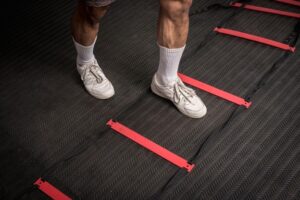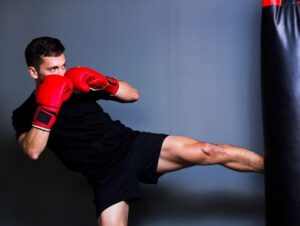Kickboxing is a form of martial art that combines elements from boxing, Muay Thai, and Karate. It has become increasingly popular over the past several years due to its high-intensity nature and focus on self-defense. As with any other physical activity, mastering the right techniques is essential for kickboxing success.
The basic kickboxing technique is the same as any other martial art, with punches and kicks used to strike an opponent. However, kickboxers have developed specific techniques that capitalize on the fast-paced nature of their sport. These include combinations of strikes known as combos, powerful defensive blocks, and evasive footwork maneuvers.
Kickboxing is an energetic and exciting sport combining elements of boxing, martial arts, and aerobic exercise. Whether you’re looking to get a great workout or take on the challenge of competing professionally, kickboxing is a great way to stay active and learn some effective self-defense techniques.
In this blog post, we’ll discuss one important element of kickboxing – footwork. We’ll cover the basics of footwork, its importance in kickboxing, and some valuable techniques to help you improve your skills. Learn more about how mastering your footwork can take your kickboxing practice to the next level!
Fundamentals Of Kickboxing
Kickboxing is a martial art combining elements of boxing and karate. It requires both physical strength and mental agility to be effective. Understanding the fundamentals of kickboxing helps to break down the different components that make up this martial art.
The first component of kickboxing is physical conditioning, which includes cardiovascular exercises like running or jumping rope and strength training exercises like push-ups and pull-ups. A good kickboxer must have the strength, agility, and endurance to withstand the physical demands of a match.
The second component is technique. Different techniques are used in kickboxing, such as punches, kicks, throws, and takedowns. Learning these techniques requires practice, repetition, and an understanding of how to use them effectively in a fight.
The third component is strategy. A good kickboxer needs to be able to think on their feet and develop strategies that will give them an advantage over their opponents. This includes knowing what your opponent is doing, when to attack or defend, and how to get the most out of every fight.
The final aspect of kickboxing is mental strength. Mental toughness and focus are essential for success in this sport. A good kickboxer needs to stay calm and collected even when things aren’t going their way and push themselves to keep going no matter what.
When taken together, these elements make up the holistic approach to kickboxing. A good kickboxer will have the physical strength and agility, technique and strategy knowledge, as well as mental toughness and focus to succeed. Combined with all these components, a fighter can become an unbeatable opponent.
Understanding Footwork in Kickboxing

Footwork is one of the most essential skills to master in kickboxing. Good footwork will increase your agility, speed, and balance while giving you an edge over your opponent. It is also critical for generating power through proper body alignment and positioning.
At its core, footwork is about understanding how to move your body most efficiently. It involves learning to use correct body mechanics, perfecting your balance, and finding ways to outmaneuver an opponent through positioning. Good footwork helps you maintain a solid support base while allowing you to get into position for a punch or kick quickly.
Footwork is closely linked to overall movement and balance. It is not just about where your feet are placed but also how they move in relation to each other. You must keep your weight leaning slightly forward during a fight to quickly move in any direction without losing momentum.
Biomechanical principles play an essential role in effective footwork. Your feet should always be placed so that they are ready to move quickly and powerfully. You can maximize your power output by ensuring that your back foot is slightly behind the front foot and that you’re pushing off with both feet when attacking or defending.
Understanding the connection between proper foot positioning and power generation is essential. By positioning your feet correctly, you can ensure that all of the energy from a punch or kick is transferred into the target instead of being wasted. This will help you maximize your strikes and land them with greater force.
Related article: Ultimate Guide To Boxing Training
Types of Footwork Techniques in Kickboxing
Kickboxing is known for its high-intensity and dynamic movements. Key to this style of combat sport is the ability to move quickly, accurately, and decisively while using proper footwork. There are two main styles of footwork used in kickboxing: offensive and defensive.
Offensive footwork consists primarily of advancing and attacking movements. To master offensive footwork, fighters must be able to move quickly and decisively to create openings for attacks while avoiding being countered. This type of footwork requires strong coordination between the feet and hands to be effective.
Defensive footwork consists primarily of retreating and evasive maneuvers. This style of footwork relies on proper timing to create openings for counterattacks while maintaining a safe distance from opponents. Defensive footwork is essential for fighters looking to minimize damage taken and maximize their chances of winning.
In addition to the two main styles of footwork, kickboxers also use several other techniques. Angling is a popular technique involving small, often unpredictable steps to create openings in opponents’ defenses. Side stepping is a crucial movement used to avoid taking damage from an opponent’s strikes while countering them. Front and rear footwork are also critical for both offensive and defensive situations.
Overall, there are many different types of footwork techniques used in kickboxing. While the two main styles are offensive and defensive, many other techniques can create openings for attack or evade an opponent’s strikes. Mastering all of them is essential for any serious kickboxer looking to win in the ring.
A fighter can develop their unique kickboxing style by training different combinations of footwork with punches and kicks.
Related article: Kickboxing Vs Muay Thai
Footwork Drills and Exercises for Kickboxing

Footwork is an essential component of kickboxing that requires consistent practice. With improved footwork, you can move faster with agility and accuracy around the kickboxing ring.
Here are some of the best drills and exercises to help improve your footwork for kickboxing:
Drill 1: Jumping Rope
One of the most popular drills for kickboxing footwork is jumping rope. To do this drill, you will need a jump rope. Add footwork combinations such as jab-crosses or hooks to challenge your agility and coordination further as you become more comfortable with the drill.
- Start by standing up and getting into your fighting stance.
- Stay light on your feet and keep your knees bent throughout the drill.
- Start jumping over the rope using quick and small jump steps.
Drill 2: Shadowboxing
Shadowboxing is another excellent way to improve your kickboxing footwork.
- Begin by standing up in your fighting stance with your feet shoulder-width apart.
- Now start moving around the room, shifting your feet and maintaining a good stance with your knees bent.
Drill 3: Footwork Ladder
You must set up a footwork ladder on the ground for this drill. As you get more confident with this drill, increase the speed of your footwork and try to add some boxing combinations into it as well.
- Start by standing at one end of the ladder and then move your feet in a pattern across it, either forward or sideways.
- Make sure to be quick but still maintain your balance and good form.
Drill 4: Agility Drills
Agility drills are a great way to sharpen up your reflexes and enhance the quickness of your feet. These drills and exercises will help you take your footwork skills for kickboxing to the next level.
- Try doing lateral shuffles or running sprints, keeping light on your feet, and perfecting your form.
- You can also try doing some explosive jumps, such as box jumps or hurdle hops, to improve your agility for kickboxing.
Related article: Advanced Footwork Drills for Boxers
Tips for Enhancing Your Footwork Drills
- Keep your feet shoulder-width apart and stay light on your toes when doing footwork drills. This will help keep you nimble and quick on your feet. Also wear a foot protector for added security.
- When practicing boxing combinations, focus on maintaining good form and perfect balance.
- Use your entire body when doing footwork drills, including your arms and core. This will help you move faster and stay in control of your movements.
- Incorporate agility drills into your routine to sharpen your reflexes and enhance your quickness on the ring.
- Consistency is critical for any skill, so practice your footwork drills regularly for the best results.
- Practice your footwork drills with a partner or coach to get feedback and refine your technique.
- Lastly, have fun with it! Don’t be afraid to experiment and find the right combination of footwork drills and exercises that work best for you.
Generating Power through Footwork

Footwork is a significant component of any successful kickboxing training program. Moving swiftly and accurately around the ring is essential for defense, offense, and general ring craft. However, footwork can also generate additional power in your punches and kicks.
Weight transfer is one of the most essential concepts in kickboxing for generating power. As you move and pivot, the weight of your body should be directed into the point of contact with your strike. This will increase the force behind each punch or kick, allowing maximum damage.
In addition to weight transfer, proper stance is essential to generate more power in your strikes. You want to ensure that you’re balanced, with your feet firmly planted on the ground and your center of gravity in line with your target. This will help you generate maximum power by transferring energy from your body’s core into the strike.
Timing and rhythm are The final elements to consider when generating power through footwork. You want to be sure to throw strikes at the peak moment of your movement – when the power generated by your footwork is most effective. This will come with experience and practice, but being aware of your strikes’ timing can help maximize the power behind each one.
Using footwork effectively allows you to defend yourself in a fight and maximizes the damage you can inflict with every strike.
Related article: 5 Guidelines To Throw Boxing Combos In Ring
Footwork’s Impact on Defense
Footwork plays an essential role in kickboxing defense. Good footwork allows fighters to dodge punches, kicks, and other attacks while avoiding putting them out of position or allowing their opponent to gain ground. Moving quickly and nimbly without compromising balance is essential for a successful defensive strategy.
A fighter’s agility can be increased by focusing on footwork drills. There are a variety of exercises to practice and master, ranging from simple skipping in place to more complex patterns like shuffling and jumping jacks. To better prepare for the ring, fighters should incorporate drills that involve multiple directions and speeds.
Proper footwork techniques are critical to effective defense in kickboxing because it allows a fighter to achieve their goals without putting themselves in a vulnerable position. Through fast and agile footwork maneuvers, fighters can evade their opponent’s attacks and counterstrike without fear of retaliation. Additionally, footwork helps a fighter to maintain good balance while attacking or defending.
Footwork is an essential aspect of kickboxing defense that should be noticed. By focusing on agility drills and consistently practicing footwork techniques, fighters can successfully evade their opponents’ attacks and gain the upper hand in kickboxing matches. Good footwork brings improved balance and an increased ability to dodge punches, kicks, and other offensive moves. Good footwork strengthens a fighter’s defensive strategy, enabling them to stay on top of their game and win more matches.
Common Footwork Mistakes to Avoid

One of the most common mistakes among kickboxers is their poor footwork. Good footwork techniques are essential in the sport, enabling a fighter to move around the ring quickly and avoid getting hit by their opponent.
However, many fighters make simple errors in their footwork that can leave them vulnerable to attack. Here are some of the most common footwork mistakes to avoid when kickboxing training:
- Moving your feet too slowly: Fighters should move their feet quickly and fluidly, ensuring they always stay on balance and maintain good posture; if you struggle with slow-moving feet, practice drills that involve quick changes of direction and crossing your legs in different ways.
- Overreaching: This mistake happens when you reach too far with a strike or step and leave yourself vulnerable to your opponent’s strikes. Make sure that each of your movements is purposeful and deliberate, staying within your body’s range.
- Lifting your feet off the ground: Keep both feet firmly on the floor as much as possible. This will help you stay balanced and ensure you can quickly move back or forward if needed.
- Not using proper equipment: When practicing kickboxing techniques, it’s important to use the proper equipment. For example, Shin Instep guards and foot protectors provide extra protection for your feet and legs when training with a partner or on a heavy bag.
By avoiding these common footwork mistakes, kickboxers can become more efficient in their movements and better defend themselves against opponents. Through careful practice and commitment to developing good habits, fighters can master the fundamentals of footwork and excel in kickboxing.
In addition to avoiding the mistakes listed above, it is also essential for fighters to focus on footwork drills in their training sessions.
Related article: Common Boxing Injuries Boxers Don With Pride
Tips to Improve Your Footwork
As with any skill, it takes a lot of practice and patience to become an expert at footwork. Here are some strategies for footwork dominance that can help kickboxers to take their footwork to the next level:
- Pay attention to your balance. Make sure you always stand on both legs and maintain a good posture when moving around the ring.
- Visualize the movements you want to make before actually doing them. This will help you plan and move with intention rather than simply reacting to your opponent.
- Practice stepping in different directions. Learn to move in straight lines, side steps, and circular movements. This will help you stay unpredictable in the ring.
- Focus on speed when practicing footwork drills. The faster and more fluidly you can switch between defensive and offensive positions, the better off you’ll be when it comes time to fight.
- In order to improve your footwork in kickboxing, you will need the right equipment. Some basic items that are needed for kickboxing include boxing gloves, hand wraps, and a punching bag.
- Always wear shin guards when practicing footwork. Shin guards not only provide protection from kicks and punches, but they also allow you to practice footwork more effectively.
Related article: How to throw a Boxing Hook and Uppercut
Final Words
Having proper kickboxing footwork is essential to any successful fighter’s strategy. It is not only important for staying agile and quick on your feet, but it can also help you maintain balance while attacking or defending yourself. All kickboxers should practice their footwork technique regularly to stay ahead of the competition and have an edge over their opponents when it comes to the ring.
In addition to honing your technique, there are other things you should consider when preparing for a fight. Eating a balanced diet with plenty of protein and hydration is essential, as well as getting enough sleep to stay energized and alert. Maintaining a positive attitude is also necessary to help you stay confident and focused during the match. With the right mindset and training, you will be well on your way to mastering kickboxing.





